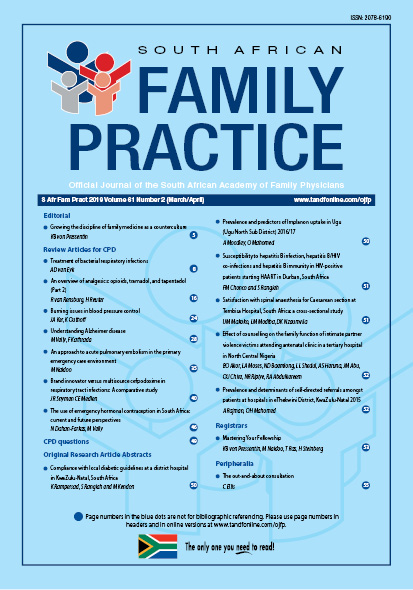Prevalence and determinants of self-directed referrals amongst patients at hospitals in eThekwini District, KwaZulu-Natal 2015
Abstract
Background: Non-compliance with designated referral pathways has ramifications such as increased patient waiting time, overburdening of higher levels of care and increasing healthcare costs on patients and the healthcare system. The purpose of this study was to assess the determinants of self-directed referrals amongst patients attending hospitals in the eThekwini district of KwaZulu-Natal.
Methods: An analytic, cross-sectional study was conducted at the Medical Outpatient Departments across five district hospitals in eThekwini using interviewer-administered questionnaires. Descriptive statistics were used to determine the proportion and the most frequent factors contributing towards patient self-referral. The likelihood of patients to self-refer was tested using chisquare (X2) and a multivariate regression model.
Results: There were 315 patients interviewed with 35% (n = 109/315) having self-referred. The majority (51%; 55/107) of selfreferrals were male and were of African race (74%; n = 80/107). Five institutional factors, namely: availability of medication at the pharmacy (98%); quality of care at the facility (93%); waiting time at facility (92%); services provided (90%); and attitude
of healthcare workers (87%), were ranked as the main drivers of self-referral. Multivariate logistic regression established a significant positive association between patient self-referral and male gender (OR 1.73; CI 1.04–2.87, p < 0.05). Age < 39 years (OR 0.96; CI 0.94–0.99, p < 0.05); and patient awareness of a referral letter (OR 0.28; CI 0.09–0.86, p < 0.05) emerged as protective factor against self-referrals.
Conclusion: Males patients tend to bypass the referral pathway whilst younger patients and patients who were aware of a referral letter were less likely to bypass the referral system. In addition to addressing the systemic challenges of waiting times, quality of care and availability of medication, a patient-oriented approach that comprises education, encouragement and increased patient awareness is an important strategy to improve referral pathway compliance.
Full text of the research articles are available online at https://doi.org/10.1080/20786190.2019.1582213

